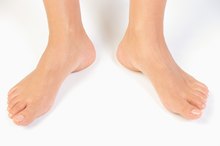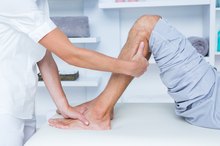What does fact checked mean?
At Healthfully, we strive to deliver objective content that is accurate and up-to-date. Our team periodically reviews articles in order to ensure content quality. The sources cited below consist of evidence from peer-reviewed journals, prominent medical organizations, academic associations, and government data.
The information contained on this site is for informational purposes only, and should not be used as a substitute for the advice of a professional health care provider. Please check with the appropriate physician regarding health questions and concerns. Although we strive to deliver accurate and up-to-date information, no guarantee to that effect is made.
How to Tell If Your Legs Are Swollen With Fluid
Edema, or excess fluid trapped in your body’s tissues, can occur in any part of your body, according to the Mayo Clinic. However, peripheral edema is abnormal fluid that settles in your legs, ankles or feet. If your legs are swollen, there can be many causes, so it’s important to consult your doctor about peripheral edema.
Tell if Your Legs are Swollen with Fluid
Recognize the signs that your legs are swollen. You probably will notice a difference in size between your legs if only one is affected. However, this is not the case if both of your legs are an abnormal size because of fluid. You also might observe puffiness or swelling of the tissue under the skin. In addition, your skin might appear shiny or stretched. Another way to tell is to lightly press your leg for several seconds; you might have edema if your skin retains a dimple or imprint after being pressed.
Fluid Buildup in the Calf
Learn More
Know the causes. It can be common for your leg to swell in certain situations, such as after standing for a long time or during a long car ride or flight. Trauma to your ankle or foot is another cause. If you are a female, pregnancy or menstrual periods can cause your leg to swell. Other common causes can be increased age or being overweight, according to Medline Plus.
Conditions like a leg infection, burns, insect bite or sting, or varicose veins can cause one or both of your legs to swell. Also, if you have had leg or foot surgery, have a blood clot or lymphatic obstruction, your leg could swell.
Understand the risks. Medical problems like liver, heart or kidney failure can cause excess fluid to build in your body and legs to swell. Other risks are diseases and illness like cirrhosis, lymphedema, nephritic syndrome. Chronic venous insufficiency (CVI), in which the veins in your legs are not able to properly pump blood to your heart, is another risk factor for peripheral edema in your legs.
Medications like anti-inflammatory drugs (NSAIDs) can make your legs swell. If you are on blood pressure medication, such as verapamil, diltiazem or nifedipine, you are at risk to develop swelling in your leg. MAO inhibitors like phenelzine, antidepressants and tricyclics like desipramine can also put you at risk. Estrogen, which is found in birth control or hormone replacement therapy, can increase your risk.
Warnings
Seek immediate medical treatment if you feel short of breath or have decreased urine output, fever or chest pain that feels like tightness or pressure.
- Recognize the signs that your legs are swollen.
- Conditions like a leg infection, burns, insect bite or sting, or varicose veins can cause one or both of your legs to swell.
Related Articles
References
- Medline Plus
- Mayo Clinic
- Adukauskiene D, Bivainyte A, Radaviciūte E. Cerebral edema and its treatment. Medicina (Kaunas). 2007;43(2):170-6.
- Cleveland Clinic. Edema.
- Ely, JW, Osheroff JA, Chamblis ML, et al. Approach to Leg Edema of Unclear Etiology. J Am Board Fam Med March 2006, 19 (2) 148-160; DOI: 10.3122/jabfm.19.2.148
- Familydoctor.org. Edema.
- Mayo Clinic. Pulmonary edema.
- Medline Plus. Edema.
- Medline Plus. Pulmonary Edema.
- National Eye Institute. Facts About Macular Edema.
- NCBI Bookshelf. Causes and signs of edema.
- Porter D. What is Macular Edema?
Warnings
- Seek immediate medical treatment if you feel short of breath or have decreased urine output, fever or chest pain that feels like tightness or pressure.








